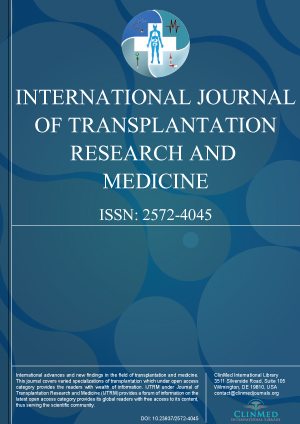Open Access DOI:10.23937/2572-4045.1510071
A Gift of Life during Life: Example of Iraqi Model for Renal Transplantation
Maha Sulaiman Younis, MD, FICMS, CABP and Omaima Khalid Yassen, MD, MBChB
Article Type: Original Article | Indexed Archive: Volume 10
Kidney transplantation (KT) is an advanced, life-saving technique for treating patients with kidney failure. This procedure has been performed in Iraq since 1973 and relies on a living kidney donor. This cross-sectional study aimed to examine the demographic characteristics of living kidney donors (KD) in Iraq and to analyse their knowledge and motivations....
Open Access DOI:10.23937/2572-4045.1510068
A New Perspective on an Old Problem: The Inferior Epigastric Artery as Inflow Target for Accessory Polar Vessels in Renal Transplantation
Animesh A Singla, FRACS (Vasc), Ramesh De Silva, MBBS, Juanita Noeline Chui, MD, Ahmer Hameed, FRACS, Taina Lee, FRACS, Jerome Laurence, FRACS, Charles Fisher, FRACS (Vasc), Lawrence Yuen, FRACS, Vikram Puttaswamy, FRACS (Vasc) and Henry Pleass, FRACS
Article Type: Original Article | Indexed Archive: Volume 9
The use of kidney allografts with multiple renal arteries (MRAs) in kidney transplantation is no longer considered a contraindication to renal transplantation. Traditional decision on best management of accessory renal vessels has been guided by surgeons’ surgical experience and institutional experience. The role of inferior epigastric artery (IEA) as an inflow vessel has often been relegated as a secondary option for allografts with MRAs due to perception of greater technical challenge and wo...
Open Access DOI:10.23937/2572-4045.1510067
Posttransplant Cutaneous Anaplastic Large Cell Lymphoma
Najoua Ammar, Mariame Meziane, Nadia Ismaili, Laila Benzekri and Karima Senouci
Article Type: Original Article | Indexed Archive: Volume 9
Post-transplant lymphoproliferative disorders (PTLD) are frequent in organ recipients; they are most often of B lymphocyte origin; on the other hand, CD30+ t-cell PTLD remain rare; we report the observation of a case of CD30+ anaplastic large cell lymphoma in a renal transplant recipient....
Open Access DOI:10.23937/2572-4045.1510066
Transanesthetic Variables that Significantly Influence the Optimal Decrease in Creatinine in Kidney Transplant
Arnulfo Calixto Flores, Adriana Graciela Zumba Pérez, Guillermo Meza Jiménez, José Cruz Santiago and Miguel Ángel Flores Meza
Article Type: Research Article | Indexed Archive: Volume 8
Anesthetic management must meet hemodynamic and pharmacological goals during renal transplantation; maintain intravascular volume; the perfused graft; control factors that influence its function. Objective: Determine if the handling of liquids; the transfusion; the hemodynamic values; the administration of diuretics and vasopressors significantly influence the optimal decrease in creatinine....
Open Access DOI:10.23937/2572-4045.1510065
Older and Bigger Living Donors for Liver Transplantation: Role of Age and BMI in Donor Selection
Patrick E. McGovern, Alexander Fagenson, Sharan Krishnan, Rohit S. Reddy, Nicholas Peterson, Charles Cole, Adam Diamond, Kelvin Lau, Antonio Di Carlo and Sunil S. Karhadkar
Article Type: Research Article | Indexed Archive: Volume 8
While obesity and age have historically limited potential living donors in the past, the points at which these factors could affect donor morbidity and mortality are unclear. We sought to identify any age and weight-based limitations for living donor for liver transplantation to expand the pool of potential donors....
Open Access DOI:10.23937/2572-4045.1510064
Indication for Heart Transplantation in a Rare Giant Unresectable Cardiac Tumor
Carlos Domínguez-Massa, Paulina M Briz-Echeverría, Eduardo Tébar-Botí, Tomás Heredia- Cambra, Javier Sirgo-González, Raquel López-Vilella, Manuel Pérez-Guillén, Luis Almenar-Bonet and Juan B Martínez-León
Article Type: Case Report | Indexed Archive: Volume 8
Primary cardiac tumors are rare, and most are benign. Cardiac lymphangiomas are extremely rare, being most frequently diagnosed casually in asymptomatic patients or upon complications derived from compression. As in most benign tumors, the treatment is resection. We report the case of a 69-year-old female who debuts with congestive heart failure and is then diagnosed with a giant unresectable lymphangioma. The literature regarding the treatment of this tumor is scarce, to the best of our knowled...

